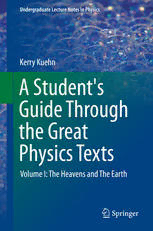
A Student's Guide Through the Great Physics Texts: Volume I: The Heavens and The Earth PDF
Preview A Student's Guide Through the Great Physics Texts: Volume I: The Heavens and The Earth
Undergraduate Lecture Notes in Physics Editors NeilAshby ProfessorEmeritus,UniversityofColorado,Boulder,CO,USA WilliamBrantley Professor,FurmanUniversity,Greenville,SC,USA MichaelFowler Professor,UniversityofVirginia,Charlottesville,VA,USA MichaelInglis Professor,SUNYSuffolkCountyCommunityCollege,Selden,NY,USA HeinzKlose ProfessorEmeritus,HumboldtUniversityBerlin,Germany HelmySherif Professor,UniversityofAlberta,Edmonton,AB,Canada Undergraduate Lecture Notes in Physics (ULNP) publishes authoritative texts covering topics throughout pure and applied physics. Each title in the series is suitable as a basis for undergraduate instruction, typically containing practice problems,workedexamples,chaptersummaries,andsuggestionsforfurtherreading. ULNPtitlesmustprovideatleastoneofthefollowing: • Anexceptionallyclearandconcisetreatmentofastandardundergraduatesubject. (cid:129) Asolidundergraduate-levelintroductiontoagraduate,advanced,ornon-standard subject. (cid:129) Anovelperspectiveoranunusualapproachtoteachingasubject. ULNPespeciallyencouragesnew,original,andidiosyncraticapproachestophysics teachingattheundergraduatelevel. ThepurposeofULNPistoprovideintriguing,absorbingbooksthatwillcontinueto bethereader’spreferredreferencethroughouttheiracademiccareer. Moreinformationaboutthisseriesathttp://www.springer.com/series/8917 Kerry Kuehn A Student’s Guide Through the Great Physics Texts Volume I: The Heavens and The Earth 2123 KerryKuehn WisconsinLutheranCollege Milwaukee Wisconsin USA ISSN2192-4791 ISSN2192-4805(electronic) ISBN978-1-4939-1359-6 ISBN978-1-4939-1360-2(eBook) DOI10.1007/978-1-4939-1360-2 SpringerNewYorkHeidelbergDordrechtLondon LibraryofCongressControlNumber:2014945636 © SpringerScience+BusinessMedia,LLC2015 Thisworkissubjecttocopyright.AllrightsarereservedbythePublisher,whetherthewholeorpartofthe materialisconcerned,specificallytherightsoftranslation,reprinting,reuseofillustrations,recitation, broadcasting,reproductiononmicrofilmsorinanyotherphysicalway,andtransmissionorinformation storageandretrieval,electronicadaptation,computersoftware,orbysimilarordissimilarmethodology nowknownorhereafterdeveloped.Exemptedfromthislegalreservationarebriefexcerptsinconnection withreviewsorscholarlyanalysisormaterialsuppliedspecificallyforthepurposeofbeingenteredand executed on a computer system, for exclusive use by the purchaser of the work. Duplication of this publicationorpartsthereofispermittedonlyundertheprovisionsoftheCopyrightLawofthePublisher’s location,initscurrentversion,andpermissionforusemustalwaysbeobtainedfromSpringer.Permissions forusemaybeobtainedthroughRightsLinkattheCopyrightClearanceCenter.Violationsareliableto prosecutionundertherespectiveCopyrightLaw. Theuseofgeneraldescriptivenames,registerednames,trademarks,servicemarks,etc.inthispublication doesnotimply,evenintheabsenceofaspecificstatement,thatsuchnamesareexemptfromtherelevant protectivelawsandregulationsandthereforefreeforgeneraluse. Whiletheadviceandinformationinthisbookarebelievedtobetrueandaccurateatthedateofpublication, neithertheauthorsnortheeditorsnorthepublishercanacceptanylegalresponsibilityforanyerrorsor omissionsthatmaybemade.Thepublishermakesnowarranty,expressorimplied,withrespecttothe materialcontainedherein. Printedonacid-freepaper SpringerispartofSpringerScience+BusinessMedia(www.springer.com) ForCindy Preface WhatistheNatureofthisBook? Thisfour-volumebookgrewfromafour-semestergeneralphysicscurriculumwhich IdevelopedandtaughtforthepastdecadetoundergraduatestudentsatWisconsin LutheranCollegeinMilwaukee.Thecurriculumisdesignedtoencourageacritical andcircumspectapproachtonaturalsciencewhileatthesametimeprovidingasuit- ablefoundationforadvancedcourseworkinphysics.Thisisaccomplishedbyholding beforethestudentsomeofthebestthinkingaboutnaturethathasbeencommittedto writing.Thescientifictextsfoundhereinareconsideredclassicspreciselybecause theyaddresstimelessquestionsinaparticularlyhonestandconvincingmanner.This doesnotmeanthateverythingtheysayistrue—infactmanyclassicscientifictexts contradictoneanother—butitisbythecarefulreading, analysisanddiscussionof the most reputable observations and opinions that one may begin to discern truth fromerror. WhoisthisBookfor? Likefinewine,theclassictextsinanydisciplinecanbeenjoyedbyboththenoviceand theconnoisseur.Forexample,Sophocles’tragicplayAntigonecanbeappreciatedby theyoungstudentwhoisdrawntothestoryoftheheroinewhobravestherighteous wrath of King Creon by choosing to illegally bury the corpse of her slain brother, andalsobytheseasonedscholarwhocarefullyevaluatestherelationshipbetween justice, divine law and the state. Likewise, Galileo’s Dialogues Concerning Two New Sciences can be enjoyed by the young student who seeks a clear geometrical descriptionofthespeedoffallingbodies, andalsobytheseasonedscholarwhois amusedbyGalileo’switandsarcasm,orwhofindsinhisDialoguestheprogressive Aristotelianismofcertainlatemedievalscholastics.1 1SeeWallace,W.A.,TheProblemofCausalityinGalileo’sScience,TheReviewofMetaphysics, 36(3),607–632,1983. vii viii Preface Havingsaidthis,Ibelievethatthisbookisparticularlysuitableforthefollowing audiences.First,itcouldserveastheprimarytextbookinanintroductorydiscussion- based physics course at the university level. It was designed to appeal to a broad constituencyofstudentsatsmallliberalartscollegeswhichoftenlacktheresources to offer the separate and specialized introductory physics courses found at many state-fundeduniversities(e.g.Physicsforpoets,Physicsforengineers,Physicsfor health-care-professionals, Physics of sports, etc.). Indeed, at my institution it is commontohavehistoryandfineartsstudentssittinginthecoursealongsidebiology andphysicsmajors.Advancedhigh-schoolorhome-schoolstudentswillfindinthis bookaphysicscurriculumthatemphasizesreadingcomprehension,andwhichcan serveasabridgeintocollege-levelwork.Itmightalsobeadoptedasasupplementary text for an advanced placement course in physics, astronomy or the history and philosophyofscience.Manypracticingphysicists,especiallythoseatthebeginning oftheirscientificcareers,maynothavetakentheopportunitytocarefullystudysome of the foundational texts of physics and astronomy. Perhaps this is because they have(quiteunderstandably)focusedtheirattentiononacquiringastrongtechnical proficiencyinanarrowsubfield.Suchindividualswillfindhereinastructuredreview of such foundational texts. This book will also likely appeal to humanists, social scientistsandmotivatedlay-readerswhoseekathematically-organizedanthologyof textswhichofferinsightintothehistoricaldevelopmentandculturalsignificanceof contemporaryscientifictheories.Finally,andmostimportantly,thisbookisdesigned forthebenefitoftheteachingprofessor.Earlyinmycareerasafacultymember,I wasaffordedconsiderablefreedomtodevelopaphysicscurriculumatmyinstitution whichwouldsustainmyinterestfortheforeseeablefuture—perhapsuntilretirement. Indeed, readingandre-readingtheclassictextsassembledhereinhasprovidedme countlesshoursofenjoyment,reflectionandinspiration. HowisthisBookUnique? Here I will offer a mild critique of textbooks typically employed in introductory universityphysicscourses.Whilewhatfollowsisadmittedlyabitofacaricature,I believeittobeaquiteplausibleone.Idothisinordertohighlighttheuniquefeatures andemphasesofthepresentbook. Inmanyuniversity-levelphysicstextbooks, the chapterformatfollowsastandardrecipe.First,acceptedscientificlawsarepresented intheformofoneormoremathematicalequations.Thisisfollowedbyafewexample problems so the student can learn how to plug numbers into the aforementioned equationsandhowtoavoidcommonconceptualorcomputationalerrors.Finally,the student is presented with contemporary applications which illustrate the relevance oftheseequationsforvariousindustrialordiagnostictechnologies. While this method often succeeds in preparing students to pass certain stan- dardized tests or to solve fairly straightforward technical problems, it is lacking in important respects. First, it is quite bland. Although memorizing formulas and learninghowtoperformnumericalcalculationsiscertainlycrucialforacquiringa Preface ix workingknowledgeofphysicaltheories,itisoftenthemoregeneralquestionsabout theassumptionsandthemethodsofsciencethatstudentsfindparticularlystimulating andenticing.Forinstance,inhisfamousMathematicalPrinciplesofNaturalPhilos- ophy,Newtonenumeratesfourgeneralrulesfordoingphilosophy.Nowthereader maycertainlychoosetorejectNewton’srules,butNewtonhimselfsuggeststhatthey arenecessaryforthesubsequentdevelopmentofhisuniversaltheoryofgravitation. Is he correct? For instance, if one rejects Rules III and IV—which articulate the principleofinduction—theninwhatsensecanhistheoryofgravitybeconsidered universal?Questionslike“isNewton’stheoryofgravitycorrect?”and“howdoyou know?” canappealtotheinnatesenseofinquisitivenessandwonderthatattracted manystudentstothestudyofnaturalscienceinthefirstplace.Moreover,inseeking asolutiontothesequestions,thestudentmusttypicallyacquireadeeperunderstand- ingofthetechnicalaspectsofthetheory.Inthisway,broadlyposedquestionscan serveasamotivationandaguidetoobtainingadetailedunderstandingofphysical theories. Second, andperhapsmoreimportantly, themethodemployedbymoststandard textbooksdoesnotpreparethestudenttobecomeapracticingscientistpreciselybe- causeittendstomaskthewayscienceisactuallydone.Thescienceispresentedas anaccomplishedfact;theprescribedquestionsrevolvelargelyaroundtechnological applications of accepted laws. On the contrary, by carefully studying the founda- tionaltextsthemselvesthestudentisexposedtothepolemicaldebates,thetechnical difficultiesandthecreativeinspirationswhichaccompaniedthedevelopmentofsci- entifictheories.Forexample,whenstudyingthemotionoffallingbodiesinGalileo’s Dialogues,thestudentmustconsideralternativeexplanationsoftheobservedphe- nomena;mustunderstandthestrengthsandweaknessesofcompetingtheories;and mustultimatelyaccept—orreject—Galileo’sproposalonthebasisofevidenceand reason.ThroughthisprocessthestudentgainsadeeperunderstandingofGalileo’s ideas,theirsignificance,andtheirlimitations. Moreover,whenstudyingthefoundationaltexts,thestudentisobligedtothought- fullyaddressissuesoflanguageandterminology—issueswhichsimplydonotarise when learning from standard textbooks. In fact, when scientific theories are being developed the scientists themselves are usually struggling to define terms which capture the essential features of their discoveries. For example, Oersted coined a termwhichistranslatedas“electricconflict”todescribetheeffectthatanelectrical currenthasonanearbymagneticcompassneedle.Hewasattemptingtodistinguish betweenthepropertiesofstationaryandmovingcharges,buthelackedthemodern conceptofthemagneticfieldwhichwaslaterintroducedbyFaraday.Whenstudents encounterafamiliartermsuchas“magneticfield,”theytypicallyacceptitassettled terminology,andtherebypresumethattheyunderstandthephenomenonbyvirtueof recognizingandmemorizingthecanonicalterm.Butwhentheyencounteranunfa- miliartermsuchas“electricconflict,”aspartofthescientificargumentfromwhich itderivesandwhereinitissituated,theyaretutoredintotheoriginalargumentand arethusobligedtothinkscientifically,alongwiththegreatscientist.Inotherwords, when reading the foundational texts, the student is led into doing science and not merelyintomemorizingandapplyingnomenclature. x Preface Generallyspeaking, thisbookdrawsupontwothingsthatwehaveincommon: (i) a shared conversation recorded in the foundational scientific texts, and (ii) an innatefacultyofreason.Thecarefulreadingandanalysisofthefoundationaltexts isextremelyvaluableinlearninghowtothinkclearlyandaccuratelyaboutnatural science.Itencouragesthestudenttocarefullydistinguishbetweenobservationand speculation,andfinally,betweentruthandfalsehood.Theabilitytodothisisessen- tial when considering the practical and even philosophical implications of various scientifictheories.Indeed,oneofthecentralaimsofthisbookistohelpthestudent grownotonlyasapotentialscientist,butasaneducatedperson.Morespecifically,it willhelpthestudentdevelopimportantintellectualvirtues(i.e.goodhabits),which willservehimorherinanyvocation,whetherinthemarketplace,inthefamily,or insociety. HowisthisBookOrganized? This book is divided into four separate volumes; the plan is to publish volumes I and II concurrently in the autumn of 2014, and volumes III and IV approximately a year later. Within each volume, the readings are centered on a particular theme and proceed chronologically. For example, Volume I is entitled The Heavens and theEarth.Itprovidesanintroductiontoastronomyandcosmologybeginningwith thegeocentrismofAristotle’sOntheHeavensandPtolemy’sAlmagest,proceeding throughheliocentrismadvancedinCopernicus’RevolutionsoftheHeavenlySpheres and Kepler’s Epitome of Copernican Astronomy, and arriving finally at big bang cosmologywithLemaître’sThePrimevalAtom.VolumeII,Space,TimeandMotion, providesacarefullookatthescienceofmotionandrest. Here, studentsengagein a detailed analysis of significant portions of Galileo’s Dialogues Concerning Two NewSciences,Pascal’sTreatiseontheEquilibriumofFluidsandtheWeightofthe MassofAir,Newton’sMathematicalPrinciplesofNaturalPhilosophyandEinstein’s Relativity. TheforthcomingVolumeIIIwilltracethetheoreticalandexperimentaldevelop- mentoftheelectromagnetictheoryoflightusingtextsbyWilliamGilbert,Benjamin Franklin,CharlesCoulomb,AndréMarieAmpère,ChristiaanHuygens,JamesClerk Maxwell,HeinrichHertz,AlbertMichelson,andothers.VolumeIVwillprovidean exploration of modern physics, focusing on radiation, atomism and the quantum theory of matter. Selections will be taken from works by Joseph Fourier, William Thomson,JosephThomson,JamesClerkMaxwell,ErnestRutherford,MaxPlanck, JamesChadwick,NielsBohr,ErwinSchrödingerandWernerHeisenberg. While the four volumes of the book are arranged around distinct themes, the readings themselves are not strictly constrained in this way. For example, in his TreatiseonLight,Huygensisprimarilyinterestedindemonstratingthatlightcanbe bestunderstoodasawavepropagatingthroughanaetherealmediumcomprisedof tiny, hard elastic particles. In so doing, he spends some time discussing the speed of light measurements performed earlier by Ole Rømer. These measurements, in
